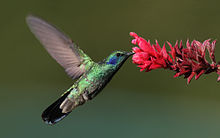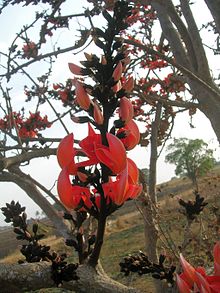- Ornithophily
-
 Hummingbird Phaethornis longirostris on an Etlingera inflorescence
Hummingbird Phaethornis longirostris on an Etlingera inflorescence
Ornithophily or Bird Pollination is the pollination of flowering plants by birds. This coevolutionary association is derived from insect pollination (entomophily) and is particularly well developed in some parts of the world, especially in the tropics and on some island chains.[1] The association involves several distinctive plant adaptations forming a "pollination syndrome". The plants typically have colourful, often red, flowers with long tubular structures holding ample nectar and orientations of the stamen and stigma that ensure contact with the pollinator. Birds involved in ornithophily tend to be specialist nectarivores with brushy tongues, long beaks, capable of hovering flight or are light enough to perch on the flower structures.
Contents
Plant adaptations
Bird pollination is considered as a costly strategy for plants and it evolves only where there are particular benefits for the plant.[4] High altitude ecosystems that lack insect pollinators, those in dry regions or isolated islands tend to favour the evolution of ornithophily in plants.[5]
Plants adaptations may be grouped into mechanisms that attract birds, those that exclude insects,[6] protect against nectar theft and pollination mechanisms in the strict sense.[5] The ovules of bird flowers also tend to have adaptations that protect them from damage.[7]
Most bird pollinated flowers are red and have a lot of nectar. They also tend to be unscented.[8] Flowers with generalist pollinators tend to have dilute nectar but those that have specialist pollinators such as hummingbirds or sunbirds tend to have more concentrated nectar.[9][10] The nectar of ornithophilous flowers vary in the sugar composition, with hexoses being high in passerine pollinated species while those that are insect pollinated tend to be sucrose rich. Hummingbird pollinated flowers however tend to be sucrose rich.[11] Many plants of the family Loranthaceae have explosive flowers that shower pollen on a bird that forages near it. They are associated mainly with flowerpeckers in the Dicaeidae family.[12] In Australia, some species of Banksia have flowers that open in response to bird actions thereby reducing the wastage of pollen.[13] As many as 129 species of North American plants have evolved ornithophilous associations.[14] Nearly a fourth of the 900 species of the genus Salvia are bird pollinated in the South African region.[15] Tropical China and the adjacent Indochinese countries harbor relatively few bird-pollinated flowers, among them the Hamamelidaceae Rhodoleia championii, which at any one site can be visited and pollinated by up to seven species of nectar-foraging birds, including Japanese white-eyes (Zosterops japonicus, Zosteropidae) and fork-tailed sunbirds (Aethopyga christinae, Nectariniidae).[16]
The rat's tail babiana (Babiana ringens Ker Gawl.) is a species of plant that produces a strong stalk within the inflorescence that serves as a perch for the Malachite Sunbird as it visits the flower.[5] Heliconias have special sticky threads that help in the adhesion of pollen to smooth structures such as the bill of a hummingbird.[17] Some African orchids of the genus Disa have pollinaria that stick to the feet of visiting sunbirds.[18]
Plants need to protect against nectar being taken by non-pollinators. These agents are classified into nectar robbers, which may destroy the flower, for example cut the flower at the base to obtain nectar and nectar thieves that obtain nectar without pollinating the flower.[19]
Bird adaptations
The main families of specialized nectar feeding birds that are involved in ornithophily are the hummingbirds (Trochilidae), sunbirds (Nectariniidae), and the honey-eaters (Meliphagidae). Other important bird groups include those in the families the Icteridae, the honeycreepers (Thraupidae, Drepanidae), white-eyes (Zosteropidae) and the South African sugar-birds (Promeropidae). Birds may obtain nectar either by perching or by hovering with the latter mainly found in the hummingbirds and sunbirds. Within the hummingbirds, two kinds of foraging are noted with territorial "hermit" hummingbirds and the non-hermits which forage longer distances [5]
Hummingbirds have the ability to digest sucrose unlike many passerines that prefer hexoses (fructose and glucose). Starlings and their relatives will completely avoid sucrose.[20] Nectar feeding birds typically have a mechanism to quickly excrete excess water. They may have to drink four to five times their body mass of liquid during the day to obtain enough energy.[21] Hummingbirds are capable of excreting nitrogenous wastes as ammonia since they can afford more water loss than birds that feed on low-moisture food sources.[22][23] Hummingbirds and sunbirds also have special anatomical and physiological adaptations that allow them to quickly excrete excess water. Hummingbirds are also able to turn off their kidney function at night.[24]
In some birds such as white-eyes, the pollen dusted by the plants on the forehead of the birds may increase the wear of these feathers leading to increased moulting and replacement.[25]
Other associations
Several mite species (mainly in the genera Proctolaelaps, Tropicoseius and Rhinoseius, family Ascidae) have evolved a phoretic mode of life, climbing into the nostrils of hummingbirds that visit flowers and hitching a ride to other flowers where they can feed on the nectar. Hummingbird flower mites favour plants in the families of Heliconiaceae, Costaceae, Zingiberaceae, Amaryllidaceae, Rubiaceae, Apocynaceae, Bromeliaceae, Gesneriaceae, Lobeliaceae and Ericaceae, members of which are associated with Hummingbirds.[26]
See also
- Zoophily (pollination by vertebrates)
References
- ^ Valido, Alfredo; Yoko L. Dupont & Jens M. Olesen (2004). "Bird–flower interactions in the Macaronesian islands" (PDF). J. Biogeogr. 31 (12): 1945–1953. doi:10.1111/j.1365-2699.2004.01116.x. http://www.biosci.ohio-state.edu/~awolfe/class/Biogeography/Readings/Culver.pdf.
- ^ Cotton, Peter A. (2001). "The Behavior and Interactions of Birds Visiting Erythrina fusca Flowers in the Colombian Amazon". Biotropica 33 (4): 662–669.
- ^ Tandon R, K. R. Shivanna & HY Mohan Ram (2003). "Reproductive Biology of Butea monosperma (Fabaceae)". Ann. Bot. 92 (5): 715–723. doi:10.1093/aob/mcg193. PMID 14500327.
- ^ Stiles, Gary F. (1978). "Ecological and Evolutionary Implications of Bird Pollination". American Zoologist 18 (4): 715–727. doi:10.1093/icb/18.4.715.
- ^ a b c d Cronk, Quentin & Isidro Ojeda (2008). "Bird-pollinated flowers in an evolutionary and molecular context". J. Exp. Bot. 59 (4): 715–727. doi:10.1093/jxb/ern009. PMID 18326865.
- ^ Castellanos M C; Wilson P; Thomson J D (2004). "'Anti-bee' and 'pro-bird' changes during the evolution of hummingbird pollination in Penstemon flowers" (PDF). Journal of evolutionary biology 17 (4): 876–85. doi:10.1111/j.1420-9101.2004.00729.x. PMID 15271088. https://www.csun.edu/~hcbio028/JEBCastellanos.pdf.
- ^ Grant, Verne (1950). "The Protection of the Ovules in Flowering Plants". Evolution 4 (3): 179–201. doi:10.2307/2405331. JSTOR 2405331.
- ^ Knudsen, Jette T., Tollsten, Lars, Groth, Inga; Bergström, Gunnar; Raguso, Robert A. (2004). "Trends in floral scent chemistry in pollination syndromes: floral scent composition in hummingbird-pollinated". Botanical Journal of the Linnean Society 146 (2): 191–199. doi:10.1111/j.1095-8339.2004.00329.x.
- ^ Johnson, Steven D & Susan W Nicolson (2008). "Evolutionary associations between nectar properties and specificity in bird pollination systems". Biol. Lett. 4 (1): 49–52. doi:10.1098/rsbl.2007.0496. PMC 2412932. PMID 17999944. http://www.pubmedcentral.nih.gov/articlerender.fcgi?tool=pmcentrez&artid=2412932.
- ^ Rodríguez-Gironés MA, Santamaría L (2004). "Why Are So Many Bird Flowers Red?". PLoS Biology 2 (10): e350. doi:10.1371/journal.pbio.0020350. PMC 521733. PMID 15486585. http://www.pubmedcentral.nih.gov/articlerender.fcgi?tool=pmcentrez&artid=521733.
- ^ Dupont, YL, Hansen, DM, Rasmussen, JT & Olesen, JM (2004). "Evolutionary changes in nectar sugar composition associated with switches between bird and insect pollination: the Canarian bird-flower element revisited". Functional Ecology 18 (5): 670–676. doi:10.1111/j.0269-8463.2004.00891.x.
- ^ Feehan, J. (1985). "Explosive flower-opening in ornithophily: A study of pollination mechanisms in some Central African Loranthaceae". Bot. J. Linn. Soc. 90 (2): 129–144. doi:10.1111/j.1095-8339.1985.tb02205.x.
- ^ Ramsey, MW (1988). "Floret Opening in Banksia menziesii R.Br.; The Importance of Nectarivorous Birds". Australian Journal of Botany 36 (2): 225–232. doi:10.1071/BT9880225.
- ^ Grant, V (1994). "Historical development of ornithophily in the western North American flora". Proc. Natl. Acad. Sci U S A. 91 (22): 10407–10411. doi:10.1073/pnas.91.22.10407. PMC 45029. PMID 7937964. http://www.pubmedcentral.nih.gov/articlerender.fcgi?tool=pmcentrez&artid=45029.
- ^ Wester, Petra; Regine Claßen-Bockhoff (2006). "Bird pollination in South African Salvia species". Flora - Morphology, Distribution, Functional Ecology of Plants 201 (5): 396–406. doi:10.1016/j.flora.2005.07.016.
- ^ Gu, Lei et al. (2010). "Passerine pollination of Rhodoleia championii (Hamamelidaceae) in subtropical China". Biotropica 42 (3): 336–341. doi:10.1111/j.1744-7429.2009.00585.x.
- ^ Rose, Marie-Jeanette & Barthlott, Wilhelm (1995). "Pollen-connecting threads in Heliconia (Heliconiaceae)". Plant Systematics and Evolution 195 (1): 61–65. doi:10.1007/BF00982315.
- ^ Gu, Lei; Luo, Zhonglai; Zhang, Dianxiang; Renner, Susanne S. (2004). "Transfer of pollinaria on birds' feet: a new pollination system in orchids". Plant Systematics & Evolution 244 (3/4): 181–188. doi:10.1111/j.1744-7429.2009.00585.x. http://onlinelibrary.wiley.com/doi/10.1111/j.1744-7429.2009.00585.x/abstract.
- ^ Valdivia, Carlos E.; Paulina L. González-Gómez (2006). "A trade-off between the amount and distance of pollen dispersal triggered by the mixed foraging behaviour of Sephanoides sephaniodes (Trochilidae) on Lapageria rosea (Philesiaceae)" (PDF). Acta Oecologica 29 (3): 324–327. doi:10.1016/j.actao.2005.12.005. http://captura.uchile.cl/dspace/bitstream/2250/2772/1/Valdivia%20CE-Trade.pdf.
- ^ Fleming, P. A.; S. Xie, K. Napier, T. J. McWhorter, S. W. Nicolson (2008). "Nectar concentration affects sugar preferences in two Australian honeyeaters and a lorikeet" (PDF). Functional Ecology 22 (4): 599–605. doi:10.1111/j.1365-2435.2008.01401.x. https://www.up.ac.za/dspace/bitstream/2263/8927/1/Fleming_Nectar(2008).pdf.
- ^ Fleming, P. A. & Nicolson, S. W. (2003). "Osmoregulation in an avian nectarivore, the whitebellied sunbird Nectarinia talatala: response to extremes of diet concentration". J. Exp. Biol. 206 (Pt 11): 1845–1854. doi:10.1242/jeb.00351. PMID 12728006.
- ^ McWhorter, T. J., Powers, D. R. & Martínez del Rio, C. (2003). "Are hummingbirds facultatively ammonotelic? Nitrogen excretion and requirements as a function of body size". Physiol. Biochem. Zool. 76 (5): 731–743. doi:10.1086/376917. PMID 14671720.
- ^ Tsahar, Ella; Martinez del Rio, Carlos; Izhaki, Ido; Arad, Zeev (2005). "Can birds be ammonotelic? Nitrogen balance and excretion in two frugivores". J. Exp. Biol. 208 (Pt 6): 1025–1034. doi:10.1242/jeb.01495. PMID 15767304.
- ^ Hartman, B B, McWhorter T.J, Tsahar E Martínez del Rio C. (2004). "Hummingbirds arrest their kidneys at night: diel variation in glomerular filtration rate in Selasphorus platycercus". J. Exp. Biol. 207 (Pt 25): 4383–4391. doi:10.1242/jeb.01238. PMID 15557024.
- ^ Craig, Adrian JFK & Patrick E Hulley (1995). "Supplementary head molt in Cape White-eyes: a consequence of nectar feeding?" (PDF). J. Field Ornithol. 67 (3): 358–359. http://elibrary.unm.edu/sora/JFO/v067n03/p0358-p0359.pdf.
- ^ Da Cruz, Denise Dias; Vanessa Holanda Righetti De Abreu & Monique Van Sluys (2007). "The Effect of Hummingbird Flower Mites on Nectar Availability of Two Sympatric Heliconia Species in a Brazilian Atlantic Forest". Annals of Botany 100 (3): 581–588. doi:10.1093/aob/mcm135. PMC 2533618. PMID 17638712. http://www.pubmedcentral.nih.gov/articlerender.fcgi?tool=pmcentrez&artid=2533618.
External links
Categories:
Wikimedia Foundation. 2010.



